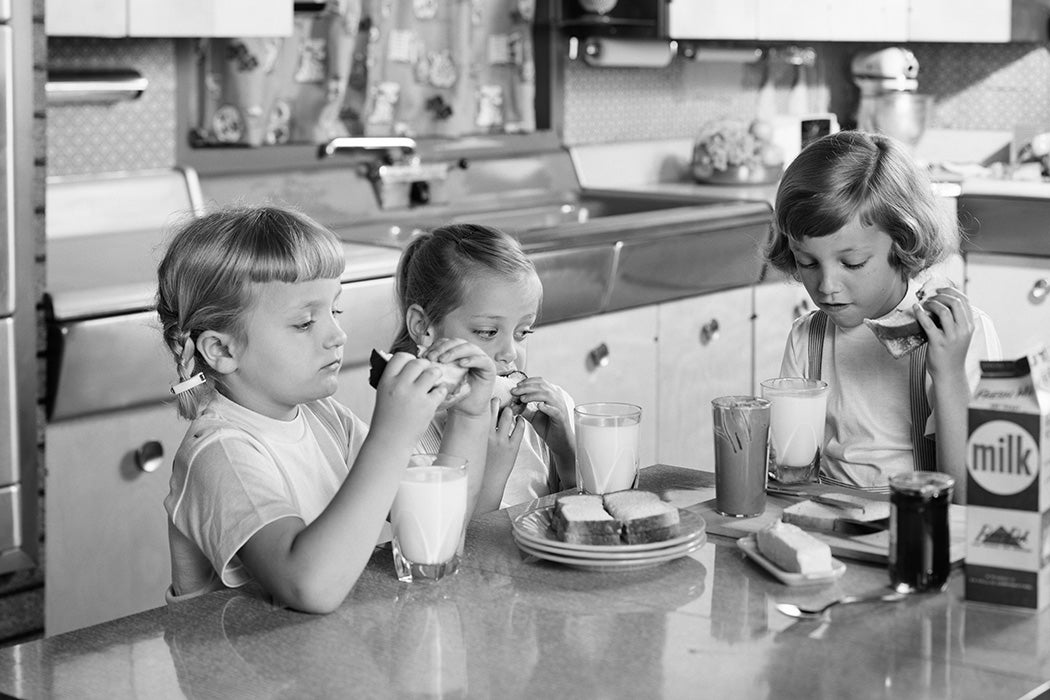There was a time when peanut butter and jelly, spread generously on two simple slices of bread, was a quintessential American meal. But sometimes a great rise can also mean a great fall. And the mighty PB&J has fallen. By the twenty-first century, historian Steve Estes writes, “the PB&J had gone from a symbol of doting mothers and idyllic childhood to a marker of negligent parenting and unhealthy kids.” What took the sandwich from iconic to outdated?
The PB&J was at its peak in the second half of the twentieth century. This was due to a few factors, Estes argues. Because you could take it anywhere, it was a bridge between public and private life: “The sandwich symbolized ‘home,’ but it was just as often eaten outside of the house” on picnics, camping trips, and school cafeterias. It also connected generations—both adults and kids enjoyed it. Lastly, it bridged economic gaps as “a staple of the working class and much of the country during times of economic hardship…. [A]ll classes of Americans munched on PB&Js.”
Though it became a food for all, the sandwich has a surprisingly elite origin.
It began as a fancy tearoom treat for the upper class. The first published mention of the sandwich was a 1901 article in Boston Cooking School Magazine, which suggested “spreading ‘peanut paste’ and ‘currant or crab-apple jelly’ on finger sandwiches.” But by the 1910s, the sandwich was being heralded as the solution to the “problem of the schoolboy’s lunch,” since it was also enjoyed by children.
Its mainstream popularity was also due to industrialization, as companies figured out how to extend the shelf-life of bread, peanut butter, and jelly. A reader and potential PB&J eater in 1901 would have likely made all three of those ingredients, but by the 1920s and 1930s, “urban American cooks were becoming more food consumers than producers,” Estes explains. Shelf-stable peanut butter hit the shelves around this time, as did the yardstick for which all great inventions are measured—sliced bread.
Now that a PB&J could be made cheaply, it became a staple as the country entered the Great Depression, finding its way into school lunches and food aid programs. But as Estes points out, it could also be part of American assimilation: “In a condescending reference to foreign and minority groups that was common for the era, the New York Times praised the government program for helping teaching non-native students to ‘eat American.’” The sandwich was well on its way to becoming not just food, but a signal of Americanness.
Weekly Newsletter
The PB&J was also heavily marketed as a good choice for families, and for Baby Boomers, it was the sandwich, as their mothers “made thousands of peanut butter and jelly sandwiches.” As this rising generation grew up, the PB&J even found its way into activist circles, with organizers for 1963’s March on Washington suggesting marchers bring the sandwich “for sustenance during the long rally.”
But by the 1990s, as concerns about processed foods and allergies began to enter the conversation, the PB&J’s popularity began to decline. But this, Estes writes, could be speaking to something much larger: “The apparent decline of the PB&J and simultaneous shrinking of the American middle class should make us reconsider the relationship between food and class in America today.”







